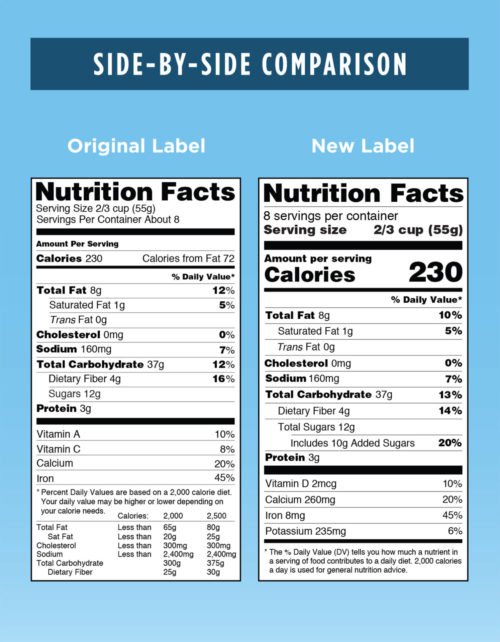At the beginning of this year an auspicious change occurred, but in all probability, not many people took notice. The nutrition facts label that appears on all packaged foods has gone through a transformation.
In 2016, The U.S. Food and Drug Administration published final rules regarding the changes and gave food manufacturers with $10 million dollars or more in annual sales until the beginning of this year to comply. Smaller companies have a year’s extension.
The changes are made to give consumers access to more recent and accurate nutrition information, particularly the link between diet and chronic diseases, such as obesity and heart disease.
More significant, however, is the addition of added sugars, or sugars and syrups that are added to foods or beverages when they are processed or prepared. Foods such as fruit and milk contain naturally occurring sugars that help fuel the body. Added sugars, on the other hand, contain no nutritional value, and provide only calories.
According to the Centers for Disease Control and Prevention, people should limit consumption of added sugars to less than 10 percent of total daily calories. The American Heart Association, however, is more stringent, and recommends a limit of nine teaspoons (36 grams or 150 calories) a day for men and six teaspoons (25 grams or 100 calories) a day for women.
A point of comparison is one 12-oucnce can of soda, which contains eight teaspoons, or 32 grams of added sugar.
Significant changes have also been made to the section on the listing of required nutrients. Vitamins A and C are no longer mandated since they are readily available in most American diets. Two nutrients ─ vitamin D and potassium ─ are now required. Both are essential nutrients, which means that they are required for normal functioning of the body. However, the body cannot manufacture them, and instead relies on you for their production. Vitamin D is necessary for bone health. Potassium helps control blood pressure.
Other nutrients, calcium and iron, remain required and are still listed on the labels.
When shopping, it’s easier to grab your food of preference and go. So what’s the value of nutrition labels? Actually, a high percentage of what we eat every day is packaged foods. Bread, cereal, salad dressings, sugary beverages, baked goods ─ they all count. Many of these foods are highly processed and contain excessive amounts of fats, sugars and sodium.
The bottom line is just as you closely scrutinize the fruits and veggies that you purchase, take a closer look at that nutrition facts label before you reach for your wallet.
From Bay State Banner





